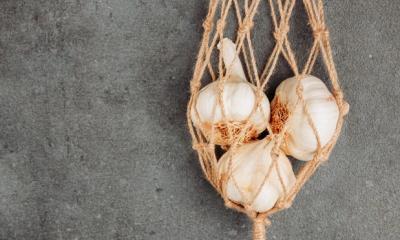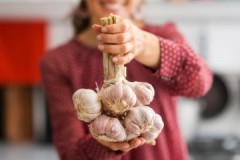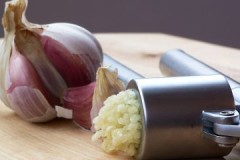Valuable tips on how to properly store onions and garlic at home
 Onions and garlic are vegetables that are traditionally prepared in winter. They are used to prepare a large number of dishes, so their stocks can be quite large.
Onions and garlic are vegetables that are traditionally prepared in winter. They are used to prepare a large number of dishes, so their stocks can be quite large.
For ease of storage, some of them are kept together. Most often, joint storage is organized for onions and garlic.
But such a neighborhood has its own characteristics that must be taken into account. We'll tell you how to store onions and garlic below.
Content
Is it possible to organize storage of vegetables together?
Onions and garlic are vegetable crops that belong to the genus Allium. This explains the fact that they have many similar characteristics regarding cultivation, harvesting and subsequent storage.
The basis for the successful preservation of collected supplies is their proper preparation. It is also important to create conditions suitable for these crops. If all the rules are followed, both vegetables will not suffer from being close to each other.
Advantages and disadvantages of shared content
When organizing joint storage of garlic and onions, it is necessary to take into account that such a neighborhood has its advantages and disadvantages.
 The obvious advantages include the following:
The obvious advantages include the following:
- saving space;
- ease of storage organization.
The disadvantages include:
- if any of the crops is infected, the entire harvest can be lost;
- Not all varieties of onions and garlic are suitable for the same conditions.
How and where is it better?
The following can be adapted for storing vegetables:
- cellar,
- loggia in the apartment,
- attic,
- a storage room or other room in which optimal conditions for temperature and humidity can be maintained.
They depend on the type of vegetable. Spring garlic is most often sent for storage, but winter varieties can also be stored in the winter. Each of them requires special conditions.
How well the onion will hold depends on the variety. Spicy varieties are best preserved, sweet ones are worse..
The place chosen for laying vegetables should be protected from light and drafts. Additionally, air circulation must be ensured. Spring varieties of garlic are best suited for keeping with onions, since their storage conditions are similar.
Selection of capacity
To store onions and garlic in winter, not only must suitable conditions be provided, but also the correct container must be selected.
Scythe
Both onions and garlic can be stored in a braid. For that to weave, you need to leave long enough stems, about 40 cm each.
Weave a braid starting with larger heads, gradually weaving in smaller ones. The number of vegetables in one bunch can be varied. A loop is left on top of the braid so that the bundle can be hung.
You can learn how to collect onions in braids from the video:
Bundle
Garlic is often stored in bunches. This method is suitable for vegetables that have 20-25 centimeters of tops left. Connecting several heads together, they are tied tightly with twine, also leaving a loop for hanging.
Box
 One of the simplest ways to organize the storage of vegetables is in a drawer or cardboard box.
One of the simplest ways to organize the storage of vegetables is in a drawer or cardboard box.
You can store onions and garlic this way. They can even be placed in one container, conditionally dividing the container into two parts.
Boxes must have holesto ensure air circulation. It is better to choose low containers so that the lower layers of vegetables do not experience excessive pressure.
In cellar conditions, you can additionally add layers, for example, with sawdust.
Box
Cardboard boxes with strong sides and bottoms are also suitable for storing bulbous plants. In order not to impede the passage of air, through holes must be made along the walls for ventilation.
Fabric bags
For storing garlic and onions small textile bags can be used. Cotton or linen should be chosen as the material for production.
Additionally, it is better to pre-soak such bags in a concentrated saline solution. After this treatment, the textiles are not rinsed, but dried immediately.
Baskets
Wicker baskets are one of the best options for organizing storage. onions and garlic for a long time. It is better to give preference to flat, low baskets that can be hung or placed on shelves.
Grids
 One of the usual ways of storing bulbous vegetables is in nets. This ensures good air passage.
One of the usual ways of storing bulbous vegetables is in nets. This ensures good air passage.
Such nets can be hung or stored on wooden shelves or platforms.
It is not advisable to build a whole mountain of mesh, since the lower layers will experience increased pressure and may deteriorate faster.
Stockings
Garlic and onions can be stored in stockings. This method will keep the vegetables in order and provide good air access. Like nets, stockings can be hung.
Banks
If you have collected relatively little garlic, it can be stored in glass jars. The heads are placed in a clean, dry container.. The top of the jar can be covered with cloth or paper.
Polyethylene lids are not suitable for this purpose, as they interfere with air circulation. Additionally, you can sprinkle the layers of heads with salt or sawdust. Details - in this article.
Prohibitions
When organizing storage, you need to remember a number of prohibitions:
- There should be no sudden temperature changes in the storage.
- Vegetables with any kind of damage should not be sent for storage.
- Unprepared vegetables should not be placed in storage. They definitely need to be dried and sorted.
- It is not advisable to put a large amount of harvest in one container. The weight of the package should optimally be up to 15 kg.
- The packaging must not be airtight, as this leads to fogging and rapid death of the harvested crop.
- It is not advisable to store vegetables simply spilled on the floor. Even when kept in bulk, it is recommended to install podiums or organize shelves.
9 recommendations to help
The following expert advice will help you when organizing vegetable storage:
 Storage conditions must be observed in the room in which the crop is located. Any violation leads to a reduction in the shelf life of vegetables and to their spoilage.
Storage conditions must be observed in the room in which the crop is located. Any violation leads to a reduction in the shelf life of vegetables and to their spoilage.- If possible, vegetables in the vegetable store should be separated not only by type, but also by variety.
- Shelf life depends on the variety.It is advisable to sort the harvest sent for storage in such a way as to be able to use vegetables with a short shelf life first, and only then more shelf-stable varieties.
- To protect against germination, the roots of the bottom of the garlic can not only be trimmed, but also cauterized.
- When preparing vegetables for storage, the length of the stems is adjusted to the storage method. For braiding, 30-40 centimeters should be left, for storage in bulk - a couple of centimeters is enough.
- Before being sent to storage, lumps of dirt and the topmost loose, loose flakes are removed from the heads of bulbous crops. It is not permissible to overdo it in this matter, since the dense top layer of husk serves as protection for the garlic heads and onions.
- At the stage of preparing vegetables for storage, the tops should not be removed until they dry out naturally.
- If the humidity in the place where the vegetables are lying is too low, you can sprinkle the garlic with onion peels.
- If there is high humidity in the vegetable storage, you can compensate for it by placing buckets of lime or ash.
Conclusion
Onions and garlic can be stored in one place. This approach allows you to compactly contain the entire crop all winter. In order for vegetables to last long, they must be properly prepared.
The more responsible you are in the process of organizing harvest storage, the longer both onions and garlic will last, maintaining their appearance and beneficial properties.


